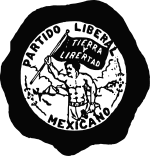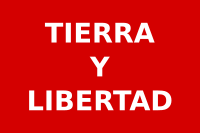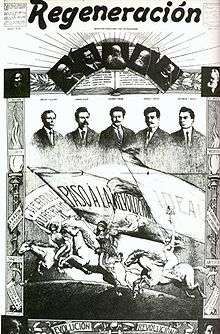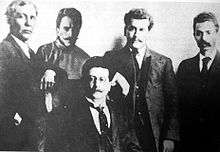Mexican Liberal Party
Mexican Liberal Party Partido Liberal Mexicano | |
|---|---|
 | |
| President | Ricardo Flores Magón |
| Vice President | Juan Sarabia (1905-1911) |
| Founded | 28 September 1905[1] |
| Dissolved | 1918 |
| Split from | Liberal Party |
| Newspaper | Regeneración |
| Ideology |
Magonism Agrarianism Social liberalism Anarchist communism |
| Political position | Far-left |
| International affiliation | None |
| Colours | Red |
| Party flag | |
 | |


The Mexican Liberal Party (PLM; Spanish: Partido Liberal Mexicano) was started in August 1900 when Ingeniero Camilo Arriga published a manifesto entitled Invitacion al Partido Liberal (Liberal Party Invitation). The invitation was addressed to Mexican liberals who were dissatisfied with the way the Porfirio Díaz government was deviating from the liberal Constitution of 1857. [2] Arriaga called on Mexican liberals to form local liberal clubs, which would then send delegates to a liberal convention. [3]
The first Mexican Liberal Party Convention was held in San Luis Potosí in February 1901. Fifty local clubs from thirteen states sent 56 delegates.[4] The Convention delegates affirmed their liberal beliefs in free speech, free press, and free assembly. They objected to the close workings of the Diaz government and the Catholic Church.[5] The convention produced fifty-one resolutions which called for the organization of the new Liberal Party, propagation of liberal principles, development of means to combat the political influence of the clergy, establishment of means to improve the administration of justice, proposals calling for guarantees of the rights of citizens and real freedom of the press, and proposals favoring complete self-government at the local level. They also called for support for free secular education in the primary schools, the spread of liberal ideas among the lower classes, the establishment of liberal publications, and the taxation of Church income.[6]
Ricardo Flores Magón attended the first Convention as a reporter for his newspaper Regeneración ("Regeneration"). He afterwards published an editorial in favorable support of the aims and aspirations. In April 1901, the new Mexican Liberal Party opened a branch in Mexico City, and Ricardo Flores Magón and his brothers joined and became active members. Always a bit more radical than most members, Flores Magón was forced into exile in January 1904. Finally settling in San Antonio, Texas, Flores Magón called for radical members of the Liberal Party to follow him in a new organization. In September 1905, the radical liberals, led by Flores Magón, formed a new organization called Junta Organizadora del Partido Liberal Mexicano (PLM). This organization would be separate from the Liberal Party, and it would seek to coordinate the violent overthrow of the Díaz government.[7] The MLP was involved in strikes and uprisings in Mexico from 1906 to 1911.
Overview
The party controlled the northern part of Baja California in 1911, including Tijuana, Mexicali, and Tecate. In August 1911 part of the MLP militants, including Juan Sarabia, Jesús Flores Magón and Antonio Díaz Soto y Gama split from the organization and transformed into the "Liberal Party" (Spanish: Partido Liberal).[8]
The MLP was supported from exile in Texas by the feminist writer Andrea Villarreal.
See also
References
- ↑ Ricardo Flores Magón - El Apóstol cautivo, tomo I, cap. 9 - El Partido Liberal Mexicano Government of Mexico (Spanish)
- ↑ Ward Albro, "Always a Rebel" 1992, p8
- ↑ Ward Albro, "Always a Rebel" 1992, p10
- ↑ Ward Albro, "Always a Rebel" 1992, p10
- ↑ Ward Albro, "Always a Rebel" 1992, p8
- ↑ Ward Albro, "Always a Rebel" 1992, p13
- ↑ Ward Albro, "Always a Rebel" 1992, p30
- ↑ John Lear - Workers, Neighbors, and Citizens: The Revolution in Mexico City. Political cultures and movilization - Maderista politics
Further reading
- Ricardo Flores Magón: Dreams of Freedom : A Ricardo Flores Magón Reader, Ak Press, 2005, ISBN 1-904859-24-0
- Javier Torres Pares: La revolucion sin frontera: El Partido Liberal Mexicano y las relaciones entre el movimiento obrero de Mexico y el de Estados Unidos, 1900–1923, Ediciones y Distribuciones Hispanicas, 1990, ISBN 968-36-1099-4
- Juan Gomez-Quinones: Sembradores: Ricardo Flores Magon y el Partido Liberal Mexicano: A Eulogy and Critique, 1973, Chicano Studies Center Publications, ISBN 0-89551-010-3
- Jeffrey Kent Lucas, The Rightward Drift of Mexico's Former Revolutionaries: The Case of Antonio Díaz Soto y Gama. Lewiston, NY: Edwin Mellen Press, 2010. ISBN 978-0-7734-3665-7.